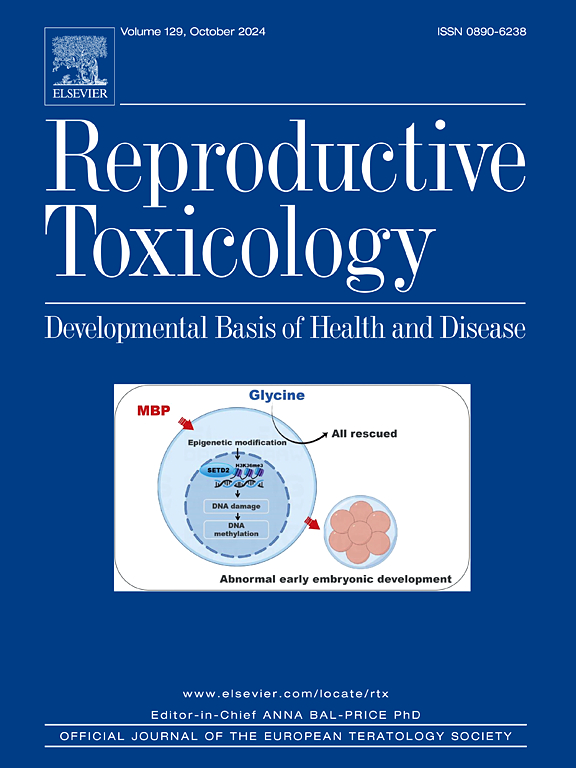Mediation of prenatal cotinine and 8-hydroxy-2’-deoxyguanosine levels on infant birth size in the Japan Environment and Children’s Study (JECS)
IF 3.3
4区 医学
Q2 REPRODUCTIVE BIOLOGY
引用次数: 0
Abstract
Prenatal passive and active smoking and oxidative stress are of concern because of their adverse effects on infant birth sizes. This study aimed to examine the mediation of maternal cotinine and 8-hydroxy-2’-deoxyguanosine (8-OHdG) levels during pregnancy on infant birth size by occupation. The study used data from 72,544 participants of the Japan Environment and Children’s Study (JECS), an ongoing nationwide prospective birth cohort. We used maternal cotinine in urine as a biomarker for prenatal passive and active smoking and maternal 8-OHdG as a biomarker for prenatal oxidative stress. In all participants, multiple linear regression analysis adjusted for covariates showed birth weight (95 % confidence interval; CI) at cotinine level 5 (active smoker level) decreased by 140 (127, 152) g compared to birth weight at cotinine level 1 (non-smoker level), and birth weight at the fourth quartile of 8-OHdG level decreased by 18 (12, 25) g compared to birth weight at the first quartile of 8-OHdG level. When stratified by maternal occupation, no association was found between the cotinine levels of maternal passive smoking exposure and birth size. The association between cotinine levels and decreased birth size in all the participants was mediated by 8-OHdG. The results showed that there was a maternal cotinine levels during pregnancy on birth size in infants.
日本环境与儿童研究(JECS)中产前可替宁和 8-羟基-2'-脱氧鸟苷水平对婴儿出生体型的调节作用
产前被动和主动吸烟和氧化应激引起关注,因为它们对婴儿出生尺寸有不利影响。本研究旨在探讨母亲可替宁和8-羟基-2 ' -脱氧鸟苷(8-OHdG)水平在怀孕期间对婴儿出生尺寸的中介作用。这项研究使用了日本环境与儿童研究(JECS)的72544名参与者的数据,这是一项正在进行的全国性前瞻性出生队列研究。我们使用孕妇尿液中的可替宁作为产前被动和主动吸烟的生物标志物,并使用孕妇8-OHdG作为产前氧化应激的生物标志物。在所有参与者中,调整协变量的多元线性回归分析显示出生体重(95 %置信区间;与可替宁水平1(非吸烟者水平)的出生体重相比,可替宁水平5(活跃吸烟者水平)的出生体重减少了140 (122,152)g,与8-OHdG水平的第一个四分位数的出生体重相比,8-OHdG水平的第四个四分位数的出生体重减少了18 (12,25)g。当按母亲职业分层时,没有发现母亲被动吸烟暴露的可替宁水平与出生大小之间的关联。所有参与者的可替宁水平与出生尺寸减小之间的关联是由8-OHdG介导的。结果表明,母亲在怀孕期间的可替宁水平对婴儿的出生尺寸有影响。
本文章由计算机程序翻译,如有差异,请以英文原文为准。
求助全文
约1分钟内获得全文
求助全文
来源期刊

Reproductive toxicology
生物-毒理学
CiteScore
6.50
自引率
3.00%
发文量
131
审稿时长
45 days
期刊介绍:
Drawing from a large number of disciplines, Reproductive Toxicology publishes timely, original research on the influence of chemical and physical agents on reproduction. Written by and for obstetricians, pediatricians, embryologists, teratologists, geneticists, toxicologists, andrologists, and others interested in detecting potential reproductive hazards, the journal is a forum for communication among researchers and practitioners. Articles focus on the application of in vitro, animal and clinical research to the practice of clinical medicine.
All aspects of reproduction are within the scope of Reproductive Toxicology, including the formation and maturation of male and female gametes, sexual function, the events surrounding the fusion of gametes and the development of the fertilized ovum, nourishment and transport of the conceptus within the genital tract, implantation, embryogenesis, intrauterine growth, placentation and placental function, parturition, lactation and neonatal survival. Adverse reproductive effects in males will be considered as significant as adverse effects occurring in females. To provide a balanced presentation of approaches, equal emphasis will be given to clinical and animal or in vitro work. Typical end points that will be studied by contributors include infertility, sexual dysfunction, spontaneous abortion, malformations, abnormal histogenesis, stillbirth, intrauterine growth retardation, prematurity, behavioral abnormalities, and perinatal mortality.
 求助内容:
求助内容: 应助结果提醒方式:
应助结果提醒方式:


